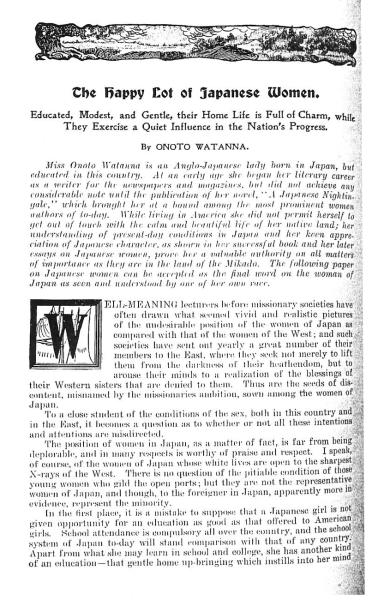The Happy Lot of Japanese Women
Well-meaning lecturers before missionary societies have often drawn what seemed vivid and realistic pictures of the undesirable position of the women of Japan as compared with that of the women of the West; and such societies have sent out yearly a great number of their members to the East, where they seek not merely to lift them from the darkness of their heathendom, but to arouse their minds to a realization of the blessings of their Western sisters that are denied to them. Thus are the seeds of discontent, misnamed by the missionaries ambition, sown among the women of Japan.
To a close student of the conditions of the sex, both in this country and in the East, it becomes a question as to whether or not all these intentions and attentions are misdirected.
The position of women in Japan, as a matter of fact, is far from being deplorable, and in many respects is worthy of praise and respect. I speak, of course, of the women of Japan whose white lives are open to the sharpest X-rays of the West. There is no question of the pitiable condition of those young women who gild the open ports; but they are not the representative women of Japan, and though, to the foreigner in Japan, apparently more in evidence, represent the minority.
In the first place, it is a mistake to suppose that a Japanese girl is not given opportunity for an education as good as that offered to American girls. School attendance is compulsory all over the country, and the school system of Japan to-day will stand comparison with that of any country. Apart from what she may learn in school and college, she has another kind of an education—that gentle home up-bringing which instills into her mind
236 from earliest childhood such qualities as modesty, meekness, politeness, gentleness, and filial obedience and respect.
The seclusion in which she lives is praiseworthy and admirable in many respects, and even her marriage to a comparative stranger to her is a far more joyful event in her life than one would imagine. Just because of her maiden life of seclusion, she is not brought into contact with the opposite sex, and, as she is essentially romantic and poetic by disposition, she looks forward to meeting and eventually marrying the young man who has been chosen for her by her honorable parents. He is the first of the opposite sex, outside her immediate family, with whom she becomes acquainted, and, unless he is repugnant to her, she allows herself to fall in love with him. She is permitted to see him several times before betrothal, and good parents do not force their children into marriages that would prove obnoxious to them.
As a wife and mother, the Japanese woman’s life is neither narrow nor limited. True, whatever public spirit she may have finds its outlet on the platform of her home, where to her immediate family she imparts such words of advice, caution, and wisdom as are often poured from the platforms of women’s clubs in America. Her home is her club and her children and husband her audience. Her duty to her race is accomplished through
237 her tender counsel and even education of these citizens. Because a Japanese woman’s voice is not heard aloud in the public affairs of the nation, be sure this is not because the country lacks women who have the spirit and the talent to help their race along in that march of progression which is the marvel of the world.
In all the world there is no more devoted husband than a Japanese, and to him his wife is his counsellor as well as his most humble servant. In the latter capacity, it is her delight to serve and minister to his wants, and to see that his home life is so full of tranquillity and repose that he may gain from it that strength with which he must gird himself to enter upon the battle of life in the great world outside the home, and in whose doings she may not take a part, save only in so far as to prepare her lord for the fray.
But is not the foundation the rock on which the most monumental structures must stand? And the women of Japan constitute the foundation stone of their country.
Too much has been written of the naïveté, the bewitching coquetry and doll-like prettiness of the women of Japan. Too little has been written of those silent, small, brave figures that stand in the background of the home life of Japan, and whose gentle influence is shown and felt in the nature and spirit of this race.
Nor, indeed, is a Japanese woman’s life entirely confined to her home. After marriage comes a pleasant social intercourse with her neighbors and friends; and while society, as it is known in the West, can hardly be said to exist save among the wives of men in the diplomatic service who are thrust into the glare of the arena which constitutes Western society in Japan, she has her own circle of good friends.
